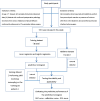Establishment and validation of a predictive nomogram for severe pleural effusion in liver cancer patients after hepatectomy
- PMID: 38457588
- PMCID: PMC10919469
- DOI: 10.1097/MD.0000000000036556
Establishment and validation of a predictive nomogram for severe pleural effusion in liver cancer patients after hepatectomy
Abstract
This study aims to develop and validate a predictive nomogram for severe postoperative pleural effusion (SPOPE) in patients undergoing hepatectomy for liver cancer. A total of 536 liver cancer patients who underwent hepatectomy at the Department of Hepatobiliary Surgery I of the Affiliated Hospital of North Sichuan Medical College from January 1, 2018, to December 31, 2022, were enrolled in a retrospective observational study and comprised the training dataset. Lasso regression and logistic regression analyses were employed to construct a predictive nomogram. The nomogram was internally validated using Bootstrapping and externally validated with a dataset of 203 patients who underwent liver cancer resection at the Department of General Surgery III of the same hospital from January 1, 2020, to December 31, 2022. We evaluated the nomogram using the receiver operating characteristic curve, calibration curve, and decision curve analysis. Variables such as drinking history, postoperative serum albumin, postoperative total bilirubin, right hepatectomy, diaphragm incision, and intraoperative blood loss were observed to be associated with SPOPE. These factors were integrated into our nomogram. The C-index of the nomogram was 0.736 (95% CI: 0.692-0.781) in the training set and 0.916 (95% CI: 0.872-0.961) in the validation set. The nomogram was then evaluated using sensitivity, specificity, positive predictive value, negative predictive value, calibration curve, and decision curve analysis. The nomogram demonstrates good discriminative ability, calibration, and clinical utility.
Copyright © 2024 the Author(s). Published by Wolters Kluwer Health, Inc.
Conflict of interest statement
The authors have no conflicts of interest to disclose.
Figures







Similar articles
-
Influencing factors and predictive model of postoperative infection in patients with primary hepatic carcinoma.BMC Gastroenterol. 2023 Apr 12;23(1):123. doi: 10.1186/s12876-023-02713-7. BMC Gastroenterol. 2023. PMID: 37046206 Free PMC article.
-
Predicting symptomatic post-hepatectomy liver failure in patients with hepatocellular carcinoma: development and validation of a preoperative nomogram.Eur Radiol. 2023 Nov;33(11):7665-7674. doi: 10.1007/s00330-023-09803-w. Epub 2023 Jun 14. Eur Radiol. 2023. PMID: 37314474
-
Nomogram for individualised prediction of liver failure risk after hepatectomy in patients with resectable hepatocellular carcinoma: the evidence from ultrasound data.Eur Radiol. 2018 Feb;28(2):877-885. doi: 10.1007/s00330-017-4900-2. Epub 2017 Aug 4. Eur Radiol. 2018. PMID: 28779402
-
A nomogram for predicting post-hepatectomy liver failure in patients with hepatocellular carcinoma based on spleen-volume-to-platelet ratio.Asian J Surg. 2023 Jan;46(1):399-404. doi: 10.1016/j.asjsur.2022.05.001. Epub 2022 May 20. Asian J Surg. 2023. PMID: 35599113
-
[Risk factor analysis on body mass rebound after laparoscopic sleeve gastrectomy and establishment of a nomogram prediction model].Zhonghua Wei Chang Wai Ke Za Zhi. 2022 Oct 25;25(10):913-920. doi: 10.3760/cma.j.cn441530-20220418-00159. Zhonghua Wei Chang Wai Ke Za Zhi. 2022. PMID: 36245117 Chinese.
References
-
- Yang A, Zhang P, Sun Z, et al. . Lysionotin induces apoptosis of hepatocellular carcinoma cells via caspase-3 mediated mitochondrial pathway. Chem Biol Interact. 2021;344:109500. - PubMed
-
- Department of Medical Administration, National Health and Health Commission of the People’s Republic of China. [Guidelines for diagnosis and treatment of primary liver cancer in China (2019 edition)]. Zhonghua Gan Zang Bing Za Zhi. 2020;28:112–8. Chinese. - PubMed
-
- Colasanti M, Berardi G, Mariano G, et al. . Laparoscopic left hepatectomy for hepatocellular carcinoma recurrence following liver transplantation. Ann Surg Oncol. 2022;29:2984. - PubMed
-
- Fuks D, Cauchy F, Fteriche S, et al. . Laparoscopy decreases pulmonary complications in patients undergoing major liver resection: a propensity score analysis. Ann Surg. 2016;263:353–61. - PubMed
Publication types
MeSH terms
LinkOut - more resources
Full Text Sources
Medical

